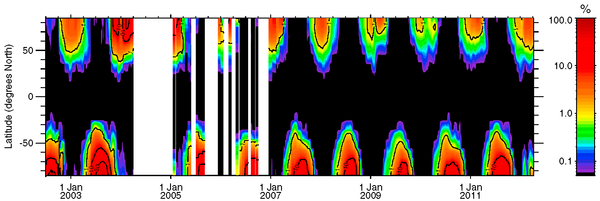First full quantification of EPP produced NOy contribution to the stratospheric budget

This study provides the first assessment of EPP-NOy intrusions into the stratosphere based on globally available MIPAS satellite data on a decadal scale (2002 - 2012). The figure shows the relative contribution of EPP-produced NOy to the stratospheric and lower mesospheric total NOy column between 20 and 70 km (40–0.02 hPa). Black contour lines mark the 1%, 10%, and 30% levels.
Global distributions of the six principal reactive nitrogen (NOy) compounds (HNO3, NO2, NO, N2O5, ClONO2, HNO4) have been derived from MIPAS mid-infrared limb emission spectra for the period 2002–2012. The obtained data set provides a unique climatological record of NOy in the middle atmosphere. The contribution of NOy produced by energetic particle precipitation (EPP) has been discriminated from that produced by N2O oxidation using a tracer correlation method based on MIPAS CH4 and CO observations. The EPP-NOy distributions, obtained in the vertical range 20–70 km, allow to trace odd nitrogen polar winter descent from the mesosphere down to the middle and lower stratosphere, where it contributes to catalytic ozone destruction. Highest EPP-NOy concentrations (up to 1 ppmv) are found in the winter solstice mesosphere, decreasing continuously with time and toward lower altitudes. Springtime peak concentrations of a few parts per billion by volume are observed at 22–25 km, demonstrating a regular EPP impact on the entire stratosphere. The interannual variation shows a clear solar cycle signal in consonance with geomagnetic activity variations. A pronounced hemispheric asymmetry of EPP-NOy is observed, with higher concentrations in the Southern Hemisphere (SH) and stronger variability in the Northern Hemisphere (NH). Poleward of 60o, EPP-NOy contributes to the winter NOy column at 20–70 km by 10–40% in the SH and 1–30% in the NH. Smaller contributions (0.1–1%) are found at midlatitudes (30o–60o).
More information: http://onlinelibrary.wiley.com/doi/10.1002/2013JD021404/abstract
